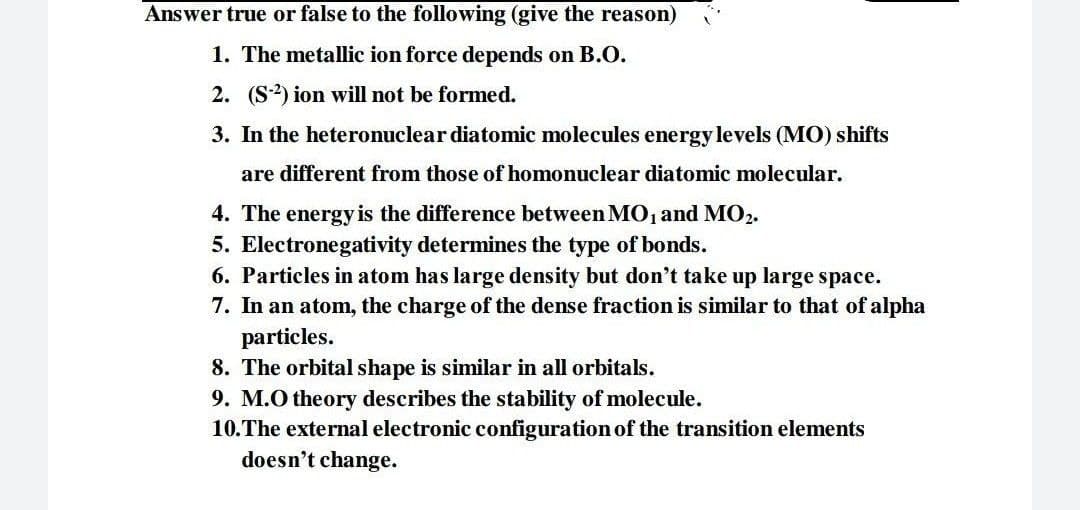Answer true or false to the following (give the reason) 1. The metallic ion force depends on B.O. 2. (S) ion will not be formed. 3. In the heteronuclear diatomic molecules energy levels (MO) shifts are different from those of homonuclear diatomic molecular. 4. The energy is the difference between MO, and MO2. 5. Electronegativity determines the type of bonds. 6. Particles in atom has large density but don't take up large space. 7. In an atom, the charge of the dense fraction is similar to that of alpha particles. 8. The orbital shape is similar in all orbitals. 9. M.O theory describes the stability of molecule. 10.The external electronic configuration of the transition elements doesn't change.
Answer true or false to the following (give the reason) 1. The metallic ion force depends on B.O. 2. (S) ion will not be formed. 3. In the heteronuclear diatomic molecules energy levels (MO) shifts are different from those of homonuclear diatomic molecular. 4. The energy is the difference between MO, and MO2. 5. Electronegativity determines the type of bonds. 6. Particles in atom has large density but don't take up large space. 7. In an atom, the charge of the dense fraction is similar to that of alpha particles. 8. The orbital shape is similar in all orbitals. 9. M.O theory describes the stability of molecule. 10.The external electronic configuration of the transition elements doesn't change.
Chemistry & Chemical Reactivity
10th Edition
ISBN:9781337399074
Author:John C. Kotz, Paul M. Treichel, John Townsend, David Treichel
Publisher:John C. Kotz, Paul M. Treichel, John Townsend, David Treichel
Chapter8: Bonding And Molecular Structure
Section: Chapter Questions
Problem 91IL: A paper published in the research Journal Science in 2007 (S. Vallina and R. Simo, Science, Vol....
Related questions
Question

Transcribed Image Text:Answer true or false to the following (give the reason)
1. The metallic ion force depends on B.O.
2. (S) ion will not be formed.
3. In the heteronuclear diatomic molecules energy levels (MO) shifts
are different from those of homonuclear diatomic molecular.
4. The energy is the difference between MO, and MO2.
5. Electronegativity determines the type of bonds.
6. Particles in atom has large density but don't take up large space.
7. In an atom, the charge of the dense fraction is similar to that of alpha
particles.
8. The orbital shape is similar in all orbitals.
9. M.O theory describes the stability of molecule.
10.The external electronic configuration of the transition elements
doesn't change.
Expert Solution
This question has been solved!
Explore an expertly crafted, step-by-step solution for a thorough understanding of key concepts.
Step by step
Solved in 2 steps

Knowledge Booster
Learn more about
Need a deep-dive on the concept behind this application? Look no further. Learn more about this topic, chemistry and related others by exploring similar questions and additional content below.Recommended textbooks for you

Chemistry & Chemical Reactivity
Chemistry
ISBN:
9781337399074
Author:
John C. Kotz, Paul M. Treichel, John Townsend, David Treichel
Publisher:
Cengage Learning

Chemistry & Chemical Reactivity
Chemistry
ISBN:
9781133949640
Author:
John C. Kotz, Paul M. Treichel, John Townsend, David Treichel
Publisher:
Cengage Learning

Chemistry by OpenStax (2015-05-04)
Chemistry
ISBN:
9781938168390
Author:
Klaus Theopold, Richard H Langley, Paul Flowers, William R. Robinson, Mark Blaser
Publisher:
OpenStax

Chemistry & Chemical Reactivity
Chemistry
ISBN:
9781337399074
Author:
John C. Kotz, Paul M. Treichel, John Townsend, David Treichel
Publisher:
Cengage Learning

Chemistry & Chemical Reactivity
Chemistry
ISBN:
9781133949640
Author:
John C. Kotz, Paul M. Treichel, John Townsend, David Treichel
Publisher:
Cengage Learning

Chemistry by OpenStax (2015-05-04)
Chemistry
ISBN:
9781938168390
Author:
Klaus Theopold, Richard H Langley, Paul Flowers, William R. Robinson, Mark Blaser
Publisher:
OpenStax

Chemistry: An Atoms First Approach
Chemistry
ISBN:
9781305079243
Author:
Steven S. Zumdahl, Susan A. Zumdahl
Publisher:
Cengage Learning

Chemistry
Chemistry
ISBN:
9781305957404
Author:
Steven S. Zumdahl, Susan A. Zumdahl, Donald J. DeCoste
Publisher:
Cengage Learning
